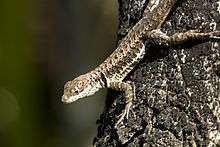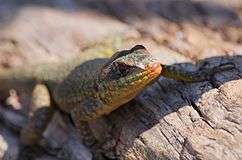Tropidurus torquatus
Tropidurus torquatus is a species of lizard in the family Tropiduridae, the Neotropical ground lizards. Its common name is Amazon lava lizard.[1]
| Tropidurus torquatus | |
|---|---|
 | |
| Scientific classification | |
| Kingdom: | Animalia |
| Phylum: | Chordata |
| Class: | Reptilia |
| Order: | Squamata |
| Suborder: | Iguania |
| Family: | Tropiduridae |
| Genus: | Tropidurus |
| Species: | T. torquatus |
| Binomial name | |
| Tropidurus torquatus (Wied-Neuwied, 1820) | |
| Synonyms | |
Etymology
The specific name, torquatus, is Latin meaning "adorned with a neck chain or collar".

Geographic range
It is native to South America, where it can be found in Argentina, Bolivia, Brazil, Colombia, French Guiana, Guyana, and Suriname.[1] It is one of the most widely distributed species of genus Tropidurus.[4]
Description
This is a medium-sized lizard with a relatively large head. Its scales are overlapping.[4] The reproductively mature female ranges from 7 to 10 cm (2.8 to 3.9 in) snout-to-vent length (SVL).[5] One sample of adult males had a mean SVL of 8.68 cm (3.42 in),[6] while another found a mean SVL of 11 to 12 cm (4.3 to 4.7 in).[7]
Habitat
This lizard lives mainly in open habitat types, especially restinga, part of the Atlantic Forest biome. It may occupy disturbed and degraded restinga. It is also known from the Abrolhos Archipelago, indicating that it can colonize offshore islands.[8] It lives in the Cerrado.[9] It may be found in residential areas,[4][7] where it is adept at climbing the walls of houses. It is mostly ground-dwelling, living in termite nests and on or under rocks and logs.[10] It is associated with many other animals, including giant ameiva, coati, brown capuchin, guira cuckoo, and false coral snake.[11]
Diet
This species is omnivorous, eating invertebrates and plant material.[1] It favors ants,[12] and on plants it prefers the fruits and flowers.[13] It commonly eats the fruit of Chomelia obtusa, higuerón, and smilaxes.[14] It especially favors the fruit of little coca during the summer.[12]
Territoriality
The male of the species is territorial. The male performs signalling behaviors such as head-bobbing and tail-whipping and exhibits aggressive behaviors such as chasing and fighting with other males. Larger, faster males tend to dominate higher-quality territories, such as those with many hiding places and abundant sunlight. Females prefer higher-quality territories and accept the males guarding them; a male may have access to a harem of several females in a good habitat.[7]
Reproduction
The female may lay several eggs at a time, but a clutch of two is common, particularly in coastal areas.[15] Clutch sizes may be larger in other geographical ranges.[5]
Bipedalism
Another notable behavior of the species is occasional bipedal locomotion. It can run relatively quickly on its hind feet for a limited distance. It carries its body in an oblique position, lifting its hindlimbs high. It swings its forelimbs in phase with its hindlimbs, i.e. swinging its right forelimb as its right hindlimb comes up, and its left with its left.[6]
Biology
Other aspects of the biology of this species have been well-studied, from the production[9] and morphology[16] of its spermatozoa, to the histology of its liver,[17] kidneys,[18][19] and red blood cells.[20] An inventory of the parasites inside the bodies of a number of lizards found three nematode species, Physaloptera lutzi, Parapharyngodon bainae, and Oswaldofilaria chabaudi, as well as an unidentified tapeworm and an acanthocephalan.[21]
References
- Embert, D. 2010. Tropidurus torquatus. In: IUCN 2012. IUCN Red List of Threatened Species. Version 2012.2.
- Tropidurus torquatus at the Reptarium.cz Reptile Database. Accessed 2 April 2017.
- Boulenger (1885), p. 176.
- Steindorff de Arruda, Jeferson Luis; Arruda, Diego Aguiar; Cechin, Sonia Zanini (2008). "Reptilia, Squamata, Tropiduridae, Tropidurus torquatus: Distribution extension". Check List. 4 (3): 269–271. doi:10.15560/4.3.269.
- Vitt, Laurie J.; Goldberg, Stephen R. (1983). "Reproductive ecology of two tropical iguanid lizards: Tropidurus torquatus and Platynotus semitaeniatus". Copeia. 1983 (1): 131–141. doi:10.2307/1444707. JSTOR 1444707.
- Rocha-Barbosa, O.; Loguercio, M.F.C.; Velloso, A.L.R.; Bonates, A.C.C. (2008). "Bipedal locomotion in Tropidurus torquatus (Wied, 1820) and Liolaemus lutzae Mertens, 1938". Brazilian Journal of Biology. 68 (3): 649–655. doi:10.1590/S1519-69842008000300024. PMID 18833488.
- Kohlsdorf, T.; et al. (2006). "Territory quality and male dominance in Tropidurus torquatus (Squamata, Tropiduridae)" (PDF). Phyllomedusa. 5 (2): 109–118. doi:10.11606/issn.2316-9079.v5i2p109-118.
- Winck, Gisele R.; Vrcibradic, Davor; Telles, Felipe Bottona da Silva; Borges-Júnior, Vitor Nelson T.; Van Sluys, Monique; Rocha, Carlos Frederico D. (2011). "Squamata, Iguania, Anolis punctatus Daudin, 1802 and Tropidurus torquatus (Wied, 1820): Distribution extension and new records for Ilha Grande, state of Rio de Janeiro, southeastern Brazil". Check List. 7 (3): 270–271. doi:10.15560/7.3.270.
- Báo, Sônia; Vieira, Gustavo H.C.; Colli, Guarino; Wiederhecker, Helga (2001). "Spermiogenesis and testicular cycle of the lizard Tropidurus torquatus (Squamata, Tropiduridae) in the Cerrado of central Brazil". Amphibia-Reptilia. 22 (2): 217–233. doi:10.1163/15685380152030445.
- Ribeiro, L.B., et al. (2008). Thermoregulatory behavior of the saxicolous lizard, Tropidurus torquatus (Squamata, Tropiduridae), in a rocky outcrop in Minas Gerais, Brazil. Herpetological Conservation and Biology 3 (1): 63-70.
- Wiederhecker, H.C., et al. (2003). The demography of the lizard Tropidurus torquatus (Squamata, Tropiduridae) in a highly seasonal Neotropical savanna. Phyllomedusa 2 (1): 9-19.
- de Carvalho, A.L.G., et al. (2007). Feeding ecology of Tropidurus torquatus (Wied) (Squamata, Tropiduridae) in two areas with different degrees of conservation in Marambaia Island, Rio de Janeiro, Southeastern Brazil. Revista Brasileira de Zoologia 24 (1): 222-227.
- Siqueira, Carla da Costa; Kiefer, Mara Cíntia; Sluys, Monique Van; Rocha, Carlos Frederico Duarte (2010). "Plant consumption in coastal populations of the lizard Tropidurus torquatus (Reptilia: Squamata: Tropiduridae): how do herbivory rates vary along their geographic range?". Journal of Natural History. 45 (3–4): 171–182. doi:10.1080/00222933.2010.520826.
- Pietczak, Carolina; de Arruda, Jeferson Luis Steindorff; Cechin, Sonia Zanini (2013). "Frugivory and seed dispersal by Tropidurus torquatus (Squamata: Tropiduridae) in southern Brazil". Herpetological Journal. 23 (2): 75–79.
- Kiefer, M. C.; Van Sluys, M.; Rocha, C. F.D. (2008). "Clutch and egg size of the tropical lizard Tropidurus torquatus (Tropiduridae) along its geographic range in coastal eastern Brazil". Canadian Journal of Zoology. 86 (12): 1376–1388. doi:10.1139/Z08-106.
- Teixeira, R.D., et al. (1999). Ultrastructural study of the spermatozoa of the Neotropical lizards, Tropidurus semitaeniatus and Tropidurus torquatus (Squamata, Tropiduridae). Tissue & Cell 31 (3): 308-317.
- Firmiano, E.M.S., et al. (2011). Histological study of the liver of the lizard Tropidurus torquatus Wied 1820, (Squamata: Tropiduridae). J. Morphol. Sci. 28 (3): 165-170.
- Soares, A.M., and F. Fava-de-Moraes. (1983). Histochemistry of the kidney of the tropical lizard Tropidurus torquatus. Gegenbaurs Morphol. Jahrb. 129 (3): 331-344.
- Soares, A.M.; Fava-de-Moraes, F. (1984). "Morphological and morphometrical study of the kidney of the male tropical lizard Tropidurus torquatus". Anatomischer Anzeiger. 157 (5): 365–373. PMID 6529021.
- Beraldo, Flávio H.; Garcia, Célia R.S. (23 August 2007). "Divergent calcium signaling in RBCs from Tropidurus torquatus (Squamata – Tropiduridae) strengthen classification in lizard evolution". BMC Physiology. 7 (1): 7. doi:10.1186/1472-6793-7-7. ISSN 1472-6793. PMC 2018699. PMID 17716375.
- Pereira, Felipe B.; Sousa, Bernadete M.; de Souza Lima, Sueli (2012). "Helminth community structure of Tropidurus torquatus (Squamata: Tropiduridae) in a rocky outcrop area of Minas Gerais state, southeastern Brazil". Journal of Parasitology. 98 (1): 6–10. doi:10.1645/GE-2689.1. PMID 21864129.
Further reading
- Boulenger, G.A. 1885. Catalogue of the Lizards in the British Museum (Natural History). Second Edition. Volume II. Iguanidæ... London: Trustees of the British Museum (Natural History). (Taylor and Francis, printers.) xii + 497 pp. + Plates I.- XXIV. (Tropidurus torquatus, pp. 176–177.)
- Wied-Neuwied, M. 1820. Reise nach Brasilien in den Jahren 1815 bis 1817 [Volume 1]. Frankfurt am Main: H.L. Bronner. xxxvi + 380 pp. + 5 unnumbered pp. + 25 plates, 2 maps. (Stellio torquatus, p. 106.)
